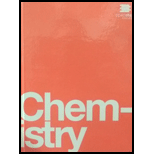
What is the difference between average rate, initial rate, and instantaneous rate?
Interpretation: The difference between average rate, initial rate, and instantaneous rate is to be determined.
Concept Introduction: The average rate is the rate of reaction over a longer period of time as compared to the instantaneous rate which is the rate at a particular instant. The initial rate is the instantaneous rate of reaction when a reaction commences.
Explanation of Solution
Average rate over a specific time period is defined as the change in a concentration over that period divided by the time interval. The initial rate is the instantaneous rate of reaction when a reaction commences, just as the new product begins to get formed. The instantaneous rate is the rate of a reaction at any specific point in time, expressed as the differential of concentration with respect to time. Thus, the average rate is the rate of reaction over a longer period of time as compared to the instantaneous rate which is the rate at a particular instant.
Want to see more full solutions like this?
Chapter 12 Solutions
Chemistry by OpenStax (2015-05-04)
Additional Science Textbook Solutions
College Physics
Introductory Chemistry (5th Edition) (Standalone Book)
General Chemistry: Principles and Modern Applications (11th Edition)
Chemistry: The Central Science (14th Edition)
- Sucrose decomposes to fructose and glucose in acid solution. A plot of the concentration of sucrose as a function of time is given in the margin. What is the rate of change of the sucrose concentration over the first 2 hours? What is the rate of change over the last 2 hours? Concentration versus time for the decomposition of sucrose.arrow_forwardSucrose decomposes to fructose and glucose in acid solution. A plot of the concentration of sucrose as a function of time is given in the margin. What is the rate of change of the sucrose concentration over the first 2 hours? What is the rate of change over the last 2 hours? Concentration versus time for the decomposition of sucrose.arrow_forwardExpress the rate of the reaction 2N2O(g)2N2(g)+O2(g) in terms of (b) [ N2O ] (a) [ O2 ]arrow_forward
- The rate of the reaction HOCH2CH2NO2+2HNO2NO2CH2CH2NO2+2H2O is 0.045molHNO2/s. What are the rates of appearance and disappearance with respect to the other three substances?arrow_forwardApply the method of initial rates to determine the order of a chemical reaction with respect to Reactant X. Create a set of hypothetical experimental data that would lead you to conclude that the reaction is second order in X.arrow_forwardThe initial rate for a reaction is equal to the slope of the tangent line at t 0 in a plot of [A] versus time. From calculus, initial rate = d[A]dt . Therefore. the differential rate law for a reaction is Rate = d[A]dt=k[A]n. Assuming you have some calculus in your background, derive the zero-, first-, and second-order integrated rate laws using the differential rate law.arrow_forward
- Write expressions like equation 20.37 for a set of three parallel reactions from the same reactant. Use k1, k2, and k3 for the three rate constants.arrow_forwardCyclobutane can decompose to form ethylene: The cyclobutane concentration can be measured as a function of time by mass spectrometry (a graph is nearby). Write an expression for the rate of reaction in terms of a changing concentration. Calculate the average rate of reaction between 10. and 30. s. Calculate the instantaneous rate of reaction after 20. s. Calculate the initial rate of reaction. Calculate the instantaneous rate of formation of ethylene 40. s after the start of the reaction.arrow_forwardThe nitration of methanol, CH3OH, by nitrous acid is thought to proceed via the following mechanism: CH3OH+H+CH3OH2+CH3OH2+CH3++H2OCH3++NO2CH3NO2 Suppose the first step is the RDS. What is the expected rate law in terms of the original reactants?arrow_forward
 Chemistry by OpenStax (2015-05-04)ChemistryISBN:9781938168390Author:Klaus Theopold, Richard H Langley, Paul Flowers, William R. Robinson, Mark BlaserPublisher:OpenStaxChemistry: Matter and ChangeChemistryISBN:9780078746376Author:Dinah Zike, Laurel Dingrando, Nicholas Hainen, Cheryl WistromPublisher:Glencoe/McGraw-Hill School Pub Co
Chemistry by OpenStax (2015-05-04)ChemistryISBN:9781938168390Author:Klaus Theopold, Richard H Langley, Paul Flowers, William R. Robinson, Mark BlaserPublisher:OpenStaxChemistry: Matter and ChangeChemistryISBN:9780078746376Author:Dinah Zike, Laurel Dingrando, Nicholas Hainen, Cheryl WistromPublisher:Glencoe/McGraw-Hill School Pub Co Physical ChemistryChemistryISBN:9781133958437Author:Ball, David W. (david Warren), BAER, TomasPublisher:Wadsworth Cengage Learning,
Physical ChemistryChemistryISBN:9781133958437Author:Ball, David W. (david Warren), BAER, TomasPublisher:Wadsworth Cengage Learning, Chemistry: Principles and ReactionsChemistryISBN:9781305079373Author:William L. Masterton, Cecile N. HurleyPublisher:Cengage Learning
Chemistry: Principles and ReactionsChemistryISBN:9781305079373Author:William L. Masterton, Cecile N. HurleyPublisher:Cengage Learning Chemistry: The Molecular ScienceChemistryISBN:9781285199047Author:John W. Moore, Conrad L. StanitskiPublisher:Cengage Learning
Chemistry: The Molecular ScienceChemistryISBN:9781285199047Author:John W. Moore, Conrad L. StanitskiPublisher:Cengage Learning ChemistryChemistryISBN:9781305957404Author:Steven S. Zumdahl, Susan A. Zumdahl, Donald J. DeCostePublisher:Cengage Learning
ChemistryChemistryISBN:9781305957404Author:Steven S. Zumdahl, Susan A. Zumdahl, Donald J. DeCostePublisher:Cengage Learning





